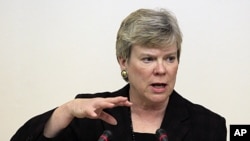“The United States is committed to the peace and security of a world without nuclear weapons,” U.S. Acting Under Secretary of State for Arms Control and International Security Rose Gottemoeller said recently in Moscow, Russia. “In order to pursue [this] goal . . . we are going to have to think bigger and bolder.”
Diplomacy is very different than it was at the dawn of the nuclear age. Treaties and agreements are not being formulated in vaulted, smoke-filled rooms, among diplomats who had to make hard copies and wait days or weeks for the snail mail. More often diplomacy is happening in the open, and at the speeds of emails and video-chats. “We diplomats must learn to work and thrive under new circumstances,” Ms. Gottemoeller said.
“Today, we verify that countries are fulfilling their arms control treaty obligations through a combination of information exchange, notifications of weapon status, on-site inspections, and National Means, including the so-called National Technical Means . . . [which are] observation satellites [and] phased-array radars . . . all [these]. . . work together to make an effective verification regime.”
The bench mark for effective verification as defined by former Ambassador Paul Nitze is: “if the other side moves beyond the limits of the treaty in any militarily significant way, we would be able to detect such violations in time to respond effectively and thereby deny the other side the benefit of the violation.”
“To help meet this benchmark . . . can we incorporate open source information technologies and social networking into arms control verification and monitoring?” Ms. Gottemoeller asked. “Open source information technologies improve arms control verification in at least two ways: either as a way of generating new information, or as analysis of information that already is out there.”
The new reality is a smaller, increasingly-networked world where the average citizen connects to other citizens in cyberspace hundreds of times each day. Why not put this vast problem solving entity to good use?
Today, any event, anywhere on the planet, could be broadcast globally in seconds. That means it is harder to hide things. When it is harder to hide things, it is easier to be caught. “The neighborhood gaze is a powerful tool,” Ms. Gottemoeller said. “It can help us make sure that countries are following the rules of arms control treaties and agreements.”
















